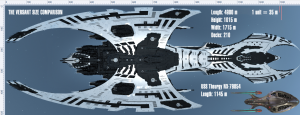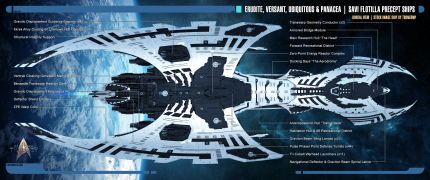The Versant: Difference between revisions
From Star Trek: Theurgy Wiki
Auctor Lucan (talk | contribs) |
Auctor Lucan (talk | contribs) |
||
| Line 153: | Line 153: | ||
====Pulse [[Phaser]] Point Defence Turrets==== | ====Pulse [[Phaser]] Point Defence Turrets==== | ||
These hull-mounted twin-mount turrets served as defence against hostile small-craft and incoming torpedoes. They were dedicated to short-range targeting and were fully automated. Hard-wired to the tactical sensors of the Precept ship, which could detect and anticipate threats against all sides of the ship, the turrets two cannons fired pulse phaser bolts equal to that of Type U+ Federation pulse phasers - the kind mounted on the fighters in the Valkyrie Program. | |||
Spread across the entire hull of the Precept ship, there were 44 turrets of this kind on the Versant. | |||
== Unique Features == | == Unique Features == | ||
Revision as of 12:42, 16 January 2018
The Versant was one of the four Precept ships of the Savi. As the largest ships in the Flotilla, with the capacity of housing over 47 000 Savi, the Precept ships were considered the pinnacle of Savi innovation in terms of habitation, research, engines and technical innovation. No Savi ship was larger, or served their research in so many different scientific fields.
Production History
Originally, the first Precept ships were round in shape, much akin to the Overseer saucer that the Asurians used in their defence force. They where large habitation domes with some propulsion systems and highly advanced subspace communication.
As of the year 2381, over one hundred years after the first Scion was born, Savi shipbuilding in general had undergone a drastic change, and over the course of the past seven years, the Precept ships of the Savi were equipped with cutting edge warfare technology, including tri-cobalt warhead launchers, graviton beam lances and an advanced pulse phaser defence system across their hulls.
When the Savi implemented the Scion gene to their species in the year 2274, witnessing the successful results of their genetically engineered evolution, their ideology about being a conservationist force changed. Instead, believing they were about to surpass the Preservers once the Scion caste dominated their species in numbers, they worked to prevent other species from inter-breeding, preemptively hindering any other society to challenge their superiority. Their own progress and improvement as a species guided them in all their actions. This drive was also the reason a select number of Scions decided to let themselves be infected by the same parasites that had taken over Starfleet Command, believing this was their next evolutionary step.
Even though the new armament of their ships were more than sufficient, even tested when applicable and without risk of discovery (without any witnesses to the tests), the Savi were, perhaps, not the most experienced in battle. Their clandestine nature prevented any deeper studies in tactics and strategy, instead relying on the high-end and superior weaponry.
Commissioned Precept-class ships
These were the active Precept ships of the Savi as of 2381:
- The Versant, deployed to the Alpha Quadrant
- The Erudite, deployed to the Beta Quadrant
- The Obiquitous, deployed to the Delta Quadrant
- The Panacea, deployed to the Gamma Quadrant
There was no fifth Precept ship under development, but the Scion leaders were rumoured to be devoting vast resources towards something else in the Flotilla.
Physical Arrangement
The current four Precept ships, the Versant included, had a distinct aesthetic that celebrated the advancement of their own species. With forward-swept arms on both sides of the bridge, reminiscent to mandibles, and a main hull that bore resemblance to that of the body of an insect, it was obvious that they were conceptualised with the Scions in mind - the genetically engineered leader caste of their people.
The head of the ship housed the main research laboratories, the armored bridge module, the Scion Captain's nest, and the forward recreational district. The neck of the ship was the anteroposterior hull, also called the transit neck, where the travel lifts connected the head with the main hull of the ship, also called the body. The body was the main habitation hull, but it also housed the ZPE-Reactor Complex and the Ventrak Cloaking generator and the Benamite Transwarp Reactor core.
On the ventral side of the ship, the Aerodrome could be found, which housed both the docking bays for the Versant's research vessel complement, along with a total capacity of 180 Initiator interceptors.
Savi Flotilla Precept Ship (Port View)
Savi Flotilla Precept Ship (Dorsal View)
Savi Flotilla Precept Ship (Aft View)
Technical Specifications
With three Graviton Beam Lances, one on each "wing" and one in the mouth of the "head", eleven tri-cobalt warhead launchers and fourty-four pulse phaser turrets for close proximity defence, the current Precept ships have taken on the specifications of a highly advanced dreadnought of immense proportions, spanning exactly 4 900 meters from aft to bow. The Precept ships were also fitted with fourteen Gravitic Displacement Engine vanes and four guidance engines to control its sub-light trajectory. The number of engines were required to propel the ship's mass, which accumulated to over 50 million metric tones.
They were powered by a Zero-Point Energy reactor in the middle of the main hull, which generated power for the ship's warp drive and virtually all of their critical systems, including their research centers and habitation sectors. Aside from the ZPE-reactor, the Precept ships also had Benamite Transwarp Reactor Core, which was stand a lone for the ship's transwarp capacity. The Ventrak Cloaking Generator was located in the aft section of the main hull, yet the dedicated cloaking emitters were located along the whole ship.
Tactical Systems
Between the years 2374 and 2381, the Savi had their Precept ships upgraded with the following advanced weaponry:
Graviton Beam Lances
With one mounted underneath the Navigational Deflector Assembly and two more located at the front of both the starboard and port side of the main hull, these cannons carried an almost unparalleled destructive yield, that both deteriorated shields at a quick rate, and then tore the targets apart with their gravitational shear. A Federation starship's shields couldn't withstand this kind of beam for more than three seconds until the deflector shields were depleted, and then the hull was split open on the fourth second. Given the fact that the beam's diameter was over 10 meters wide, and there was nothing resilient enough to stop the beam once it had passed the outer hull, a starship could be punctured straight through its saucer with a single hit.
The aquamarine beam's shearing effect held no inherent energy that could ignite a target's present on-board components. The difference could be illustrated when comparing a steel rod being rammed with enough force to pass through a person's soft tissues, instead of an energy beam burning through the body. The steel rod wouldn't ignite anything, but it would make the target bleed. It was a piercing, artificial gravitational force, so if no critical parts of a starship was hit, the ship could remain space-borne. There might be indirect effects, not caused by the beam itself, but as a result of the piercing force.
The range of the beam was virtually optical, the force abating hundreds of miles away, and could pierce any number of ships if lined up in front of each other. While no such tests have been made by the Savi, a Precept ship could theoretically open fire against a planet and - given time - puncture a hole straight down into the planet's core.
The detriment of this weapon system was that - while the middle weapon at the front of the Precept ship's head could be rotated horizontally - they were difficult to aim with, and swift evasive manoeuvres could save the target from being hit.
Tricobalt Warhead Launchers
A tricobalt warhead was a type of tricobalt explosive device utilized as a missile - meaning that it was a self-powered guided weapon. At extremely high yields, they were capable of producing disruptions or even ruptures in subspace. Tricobalt devices were not standard issue weapons on Starfleet starships, but were sometimes carried in addition to photon torpedoes. While the high yield tricobalt explosives could cause subspace ruptures to form, they were not considered to be subspace weapons, as such weapons were banned by the second Khitomer Accords. (Note: A pair of tricobalt devices, with a total yield of 20,000 teracochranes, were used by the USS Voyager in order to destroy the Caretaker's array in 2371. The explosion destroyed the station, leaving only particulate dust, vapors, and metallic fragments.)
The Versant's eleven launchers had dual launching tubes, allowing for a fire-rate of 30 warheads per minute, with two warheads launched every four seconds. Federation Starship-issue tricobalt warheads had a yield of 10,000 teracochranes, whereas the yield of these warheads were 5,000 teracochranes per warhead. Yet since they were fired simultaneously from the launching tubes, the total yield was essentially equal. A Precept ship normally carried a stockpile of 120 warheads per launcher, whereas Federation starships only carried a mere handful of these devices.
The detriment of the warheads were that they could - with great difficulty - be targeted mid-flight towards its target. Still, the detonation when hit by a phaser beam or a torpedo was significant, and could still cause damage if the warhead was intercepted too late.
Pulse Phaser Point Defence Turrets
These hull-mounted twin-mount turrets served as defence against hostile small-craft and incoming torpedoes. They were dedicated to short-range targeting and were fully automated. Hard-wired to the tactical sensors of the Precept ship, which could detect and anticipate threats against all sides of the ship, the turrets two cannons fired pulse phaser bolts equal to that of Type U+ Federation pulse phasers - the kind mounted on the fighters in the Valkyrie Program.
Spread across the entire hull of the Precept ship, there were 44 turrets of this kind on the Versant.
Unique Features
The Precept class ships, while yet to be revealed by the Savi, carried a few features considered new or unusual compared to Federation starships.
Below the armoured bridge, and the spear-like navigation and sensor array were two immense deflector dishes. Each deflector dish had the same capabilities as the other. It was possible to operate one dish at a time or to sync both. Losing a dish did not hinder the other, but could reduce the Precept ship's repulsive shield strength.
Most of the ship's offensive capacity came from the graviton beam lances, but the two deflectors were also graviton emitters. The aquamarine beams disrupted enemy shields, and once it pierced the shields, it would use its piercing lances to cause damage through gravimetric shear. The two deflectors were considered one of the most important parts on the ship in terms of defensive and offensive capacity.
Repulsive Shielding
A significant technical improvement compared to the Overseer class saucers - that were originally made by the Savi - was the inclusion of Repulsive Shielding. The concept of the shielding was to disperse the incoming fire and subsequent damage through oscillation of the shields, creating a ripple effect that spread the impact out to reduce the overall magnitude. In practical studies by the Savi, this was shown to reduce energy loss by 35%. It also improved shielding near the front and back, where the shield bubble was less pronounced. Impact with these areas actually saw a 50% decrease in shield energy loss as the thinner surface area actually saw some of the blast spread off the shields entirely into empty space.
Ventrak Cloaking
Ventrak Cloaking was a type of cloaking device developed by the Savi for the purpose of remaining unseen while observing. A Precept ship's shields dropped automatically on activation of the cloaking device. This left the ship vulnerable for a second before the cloaking field formed, and a half second after it dropped.
While cloaking, the ship's movement did not set off any motion tracking sensors, nor did light 'shimmer' around it. Most modern day sensors couldn't pick up on a Ventrak cloaked object, and Ventrak cloaking did not leave behind any particles to detect it, making it a nearly 'perfect' cloaking device. The energy spike of the ZPE-reactor when powering weapon systems and shielding interfered, however, with the Ventrak cloak, and to fire weapons or raise shields required the cloaking to be dropped.
Kkrek Alloy
Kkrek was a thin, silver-translucent, non-Newtonian liquid at room temperature, a mixture of both natural and lab-created elements. It was a super-hydrophobic alloy that did not bond easily in the presence of other elements. It hardened permanently when exposed to high heats. The surface of heated Kkrek was extremely smooth and reduced friction to near-zero. It could sometimes feel chilly to the touch.
Kkrek alloy coating deteriorated over the span of several centuries, though hard strikes to the surface of the alloy could sometimes break the coating, leaving the surface below open to damage. Although rain and wind slid right off the alloy, hail could sometimes cause hairpin cracks that would reduce the coating's overall effectiveness, and large meteors could sometimes tear off chunks of coating all together.
A Kkrek alloy coating was one of the components that enabled a ship like the Versant to enter transwarp tunnels, along with the geometry conductors located on the head and wings of the Precept-class ships.
Benamite Transwarp Reactor
The quantum slipstream drive was an advanced form of propulsion technology that allowed Savi to travel across vast distances far exceeding conventional warp range. Many of the basic concepts and core components every Starfleet cadet took for granted in a starship’s conventional warp propulsion system such as warp nacelles, warp coils, and warp field theory and geometry had no part in the quantum slipstream drive. Usung a Benamite Reactor, the Savi Precept ship's slipstream drive allowed for travel equivalent to a conventional warp factor of 9.99998477, or 300 light years per hour.
Due to the tunnelling method of quantum slipstream travel, spacecraft designs that were smaller and/or more streamlined proved more capable of utilizing slipstream without concern for hull stresses. Consequently, the Savi had to compensate for this requirement if they were to make their Precept ships use the technology. Fortunately, a couple of thousand years past, they had discovered an unrelated technology that allowed them to utilise geometry conductors on the hulls of the ships to pass through the tunnel entrance and ensure phase variance remained stable.
As of 2381, the Savi were gathering medical data on Antes and Scions who served on vessels equipped with the Benamite Reactor for signs of any biological effects. While there still remained many unknowns regarding quantum slipstream technology, the expanded opportunities for transportation enabled for the Savi through the quantum slipstream drive were clearly evident.
Quantum Slipstream Drive
To maintain the slipstream, the phase variance of the quantum field has to be constantly adjusted or the slipstream will collapse, violently throwing the ship back into normal space.
The graviton particle actuators, which was columns that surrounded the Precept ship's Benamite Reactor, began stripping gravitons from the Benamite crystals. Through exposure to the quantum field, the gravitons became charged with quantum energy into a uniform flux state. Once enough particles were charged, they were fed through graviton transfer conduits, leading from the Benamite reactor fed directly into the slipstream initiator, located in the slipstream components in the two navigational deflectors. From here, the initiator projected the charged gravitons out in front of the ship through the deflector dishes, which creates a narrow subspace field. This split the subspace domain open for the ship to travel through.
Once the Precept ship crossed the slipstream threshold, it was extremely important to maintain a stable field in front of the ship. This required precise calculations to avoid destabilizing the slipstream and violently throwing the ship back into normal space. If the phase variance of the field went beyond 0.42, the field would collapse and there would be a catastrophic failure in the ship’s attitude control.
The flight-limitation was three hours, and once the drive was deactivated, it could not be reactivated until at least 36 hours has passed (longer depending on the state of the drive). The benamite crystals (and the geometry conductors) required a cool-down cycle due to exposure to the quantum field. Any attempt to warm-up the drive before the cool-down cycle had completed could result in an unstable slipstream or severe damage to the drive itself.
- Warm Up
- Run Level 5 Diagnostic of all Slipstream Components
- Route main power into slipstream components
- Activate Quantum Matrix Initiator in the Benamite Reactor
- Check quantum field and benamite crystal status
- Activate graviton particle actuators: begin charging gravitons with quantum energy
- Begin graviton transfer once sufficient number of gravitons are charged
- Initiation
- Charge slipstream initiators
- Align navigational deflectors for graviton projection
- Projection
- Activate slipstream initiators
- Project gravitons through navigational deflector
- Once slipstream is initiated, monitor the control matrix to ensure phase variance is stable
- Monitor all changes in subspace field stress or orders to change course
- Shutdown
- Disengage slipstream initiators
- Return navigational deflector to conventional propulsion configuration.
- Cool Down
- Deactivate graviton particle actuators
- Disengage quantum field and cut main power leads
- Run Level 4 Diagnostic of all slipstream systems
- Return to power-save mode
- Monitor benamite crystals during cool down: report any irregularities
Known Crew
- None
Disclaimer
Details about the Quantum Slipstream Drive interpreted from Starbase118's details by Nathan Baker, Atherton Grix, James, Eileen McCleran, Roshanara Rahman, Alexander Richards, and Dueld taJoot. All credit to them for the original texts, here edited to fit the Savi and the Precept ships.





